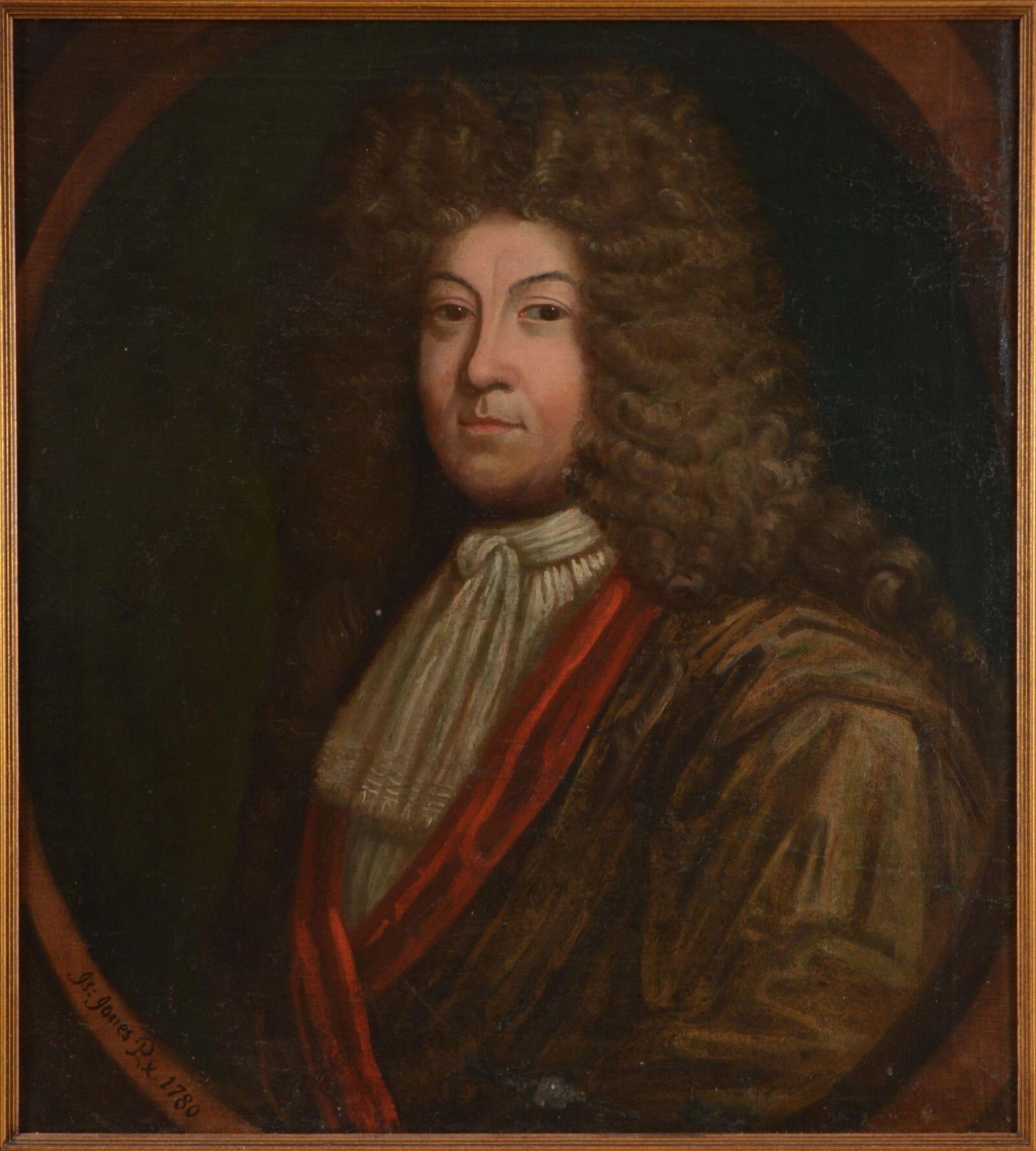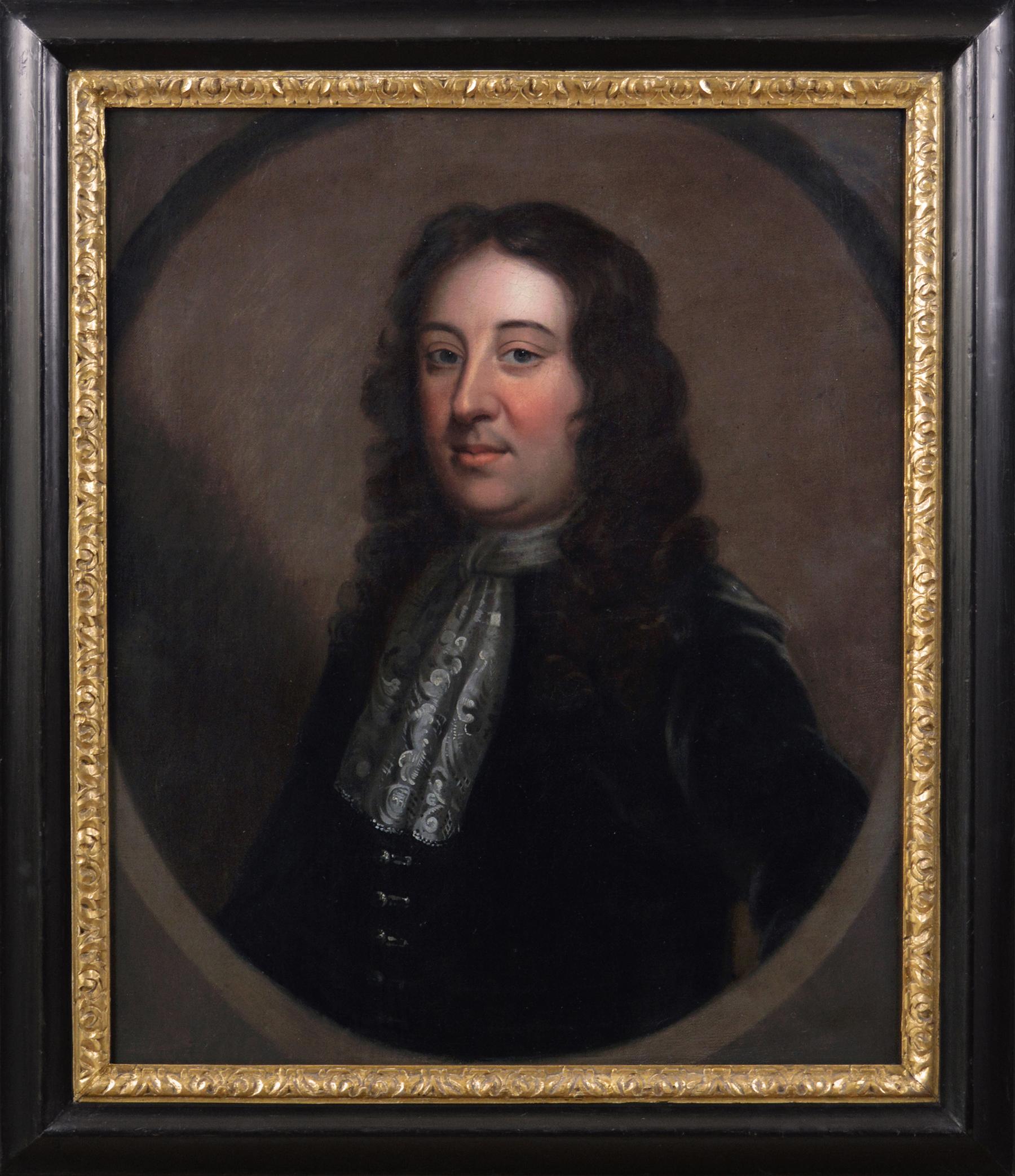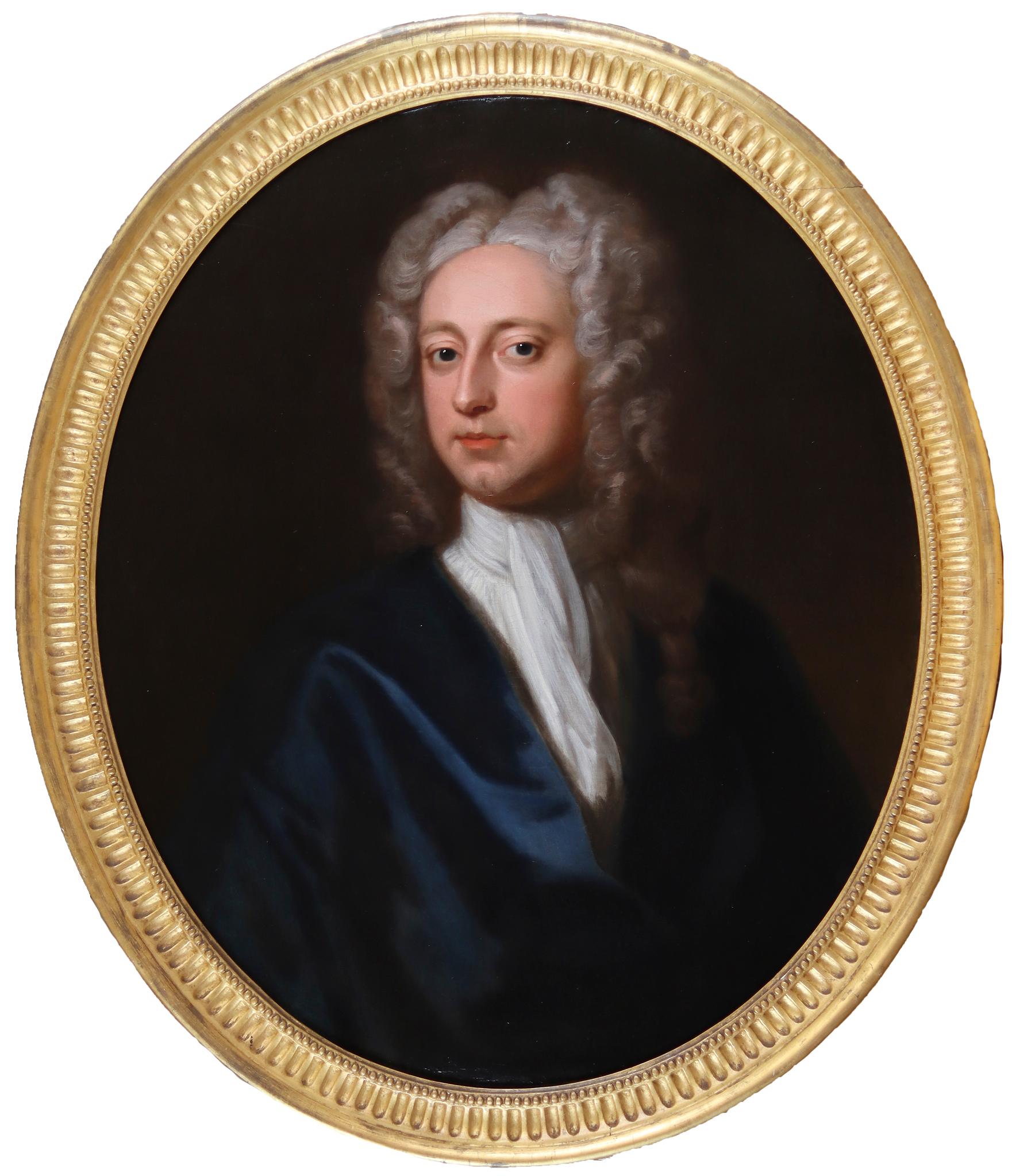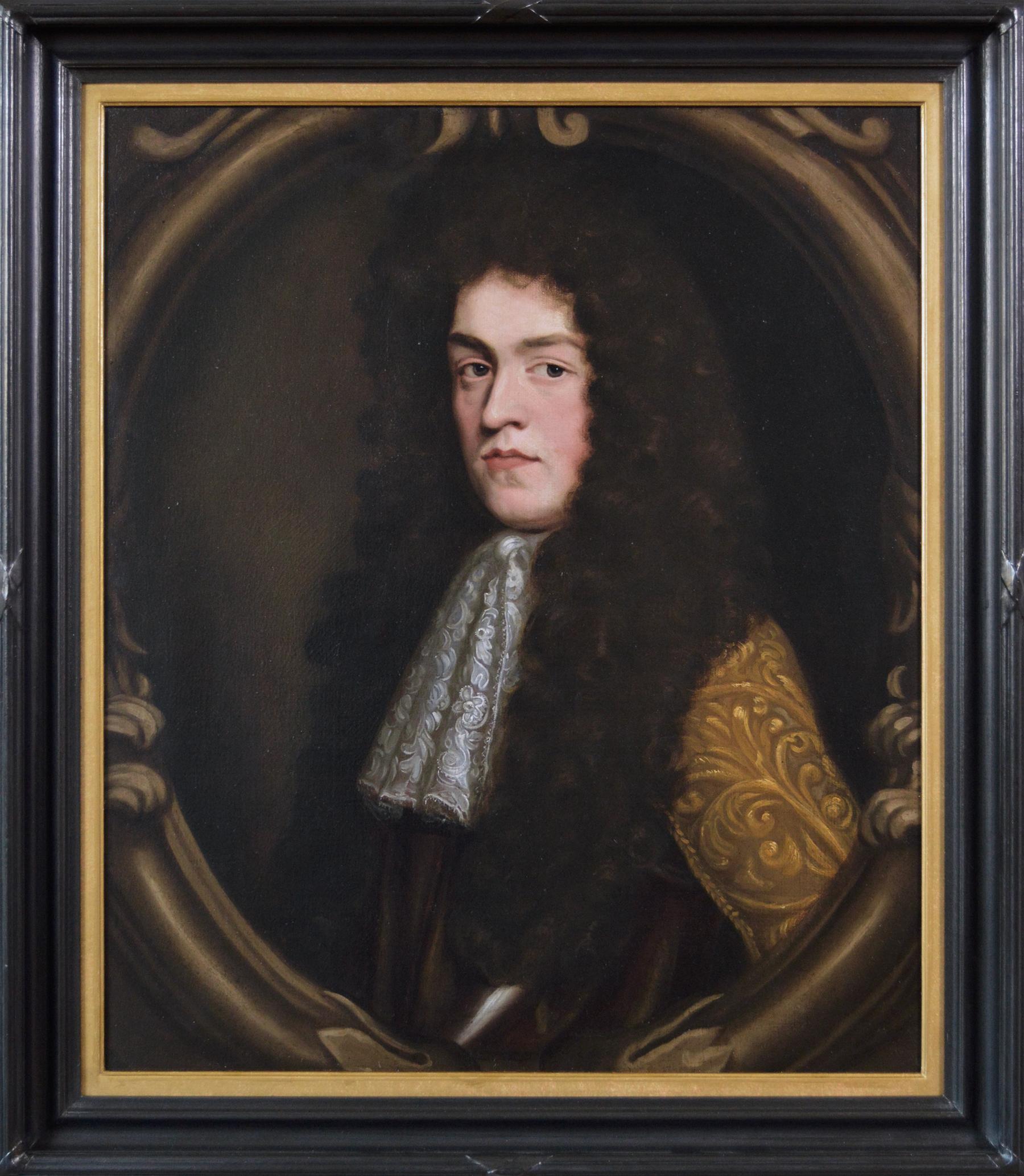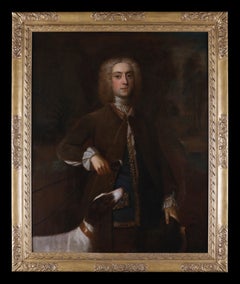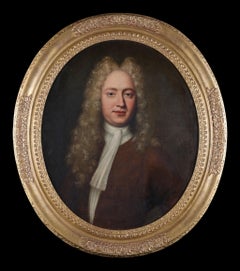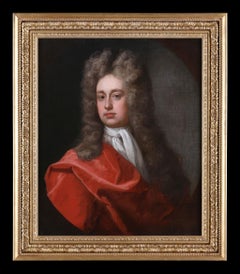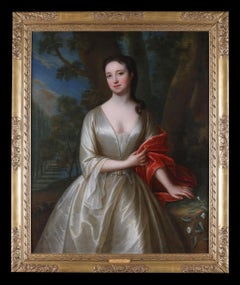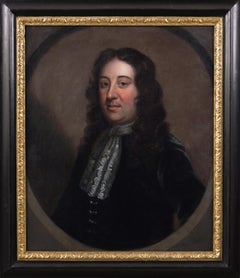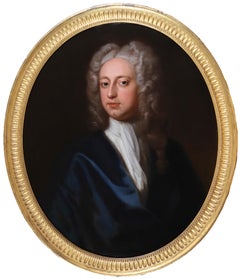Items Similar to 'Sir John Wynn, 5th Baronet' three-quarter-length portrait, oil on canvas
Want more images or videos?
Request additional images or videos from the seller
1 of 8
'Sir John Wynn, 5th Baronet' three-quarter-length portrait, oil on canvas1718
1718
$12,131.78
£8,800
€10,276.16
CA$16,774.34
A$18,416.14
CHF 9,607.74
MX$222,860.90
NOK 120,418.09
SEK 113,465.50
DKK 76,708.81
About the Item
Sir John Wynn, 5th Baronet
Canvas Size: 50 x 40" (127 x 102cm)
Outside Frame Size: 58 x 48" (147 x 122cm)
Sir John Wynn, 5th Baronet (1628 – 11 January 1719) was a Welsh landowner and Tory politician who sat in the English and British House of Commons between 1679 and 1713.
Wynnstay Estate, inherited by the 5th Baronet
Wynn was the only son of Henry Wynn of Rhiwgoch, Merioneth, and was educated at the Inner Temple, 1646. He inherited the Watstay Estate through his marriage to Jane Evans (daughter of Eyton Evans of Watstay), which he renamed the Wynnstay Estate. He also, allegedly, won the manor of Stanwardine in Shropshire from Thomas Corbett in a snail race.
He succeeded his cousin Sir Richard Wynn, 4th Baronet as a baronet in 1674 but did not inherit the Gwydyr Estate, which passed to his predecessor's daughter Mary (later wife of Robert Bertie, 1st Duke of Ancaster and Kesteven).
Wynn served as High Sheriff of Denbighshire for 1671–3, as High Sheriff of Caernarvonshire for 1674-75 and as High Sheriff of Merionethshire for 1675–1676. He was Custos Rotulorum of Merionethshire for 1678–1688, 1690–96 and 1700–1711.
Wynn was returned as Member of Parliament for Merioneth in 1679. He was returned again in 1685 and held the seat until 1695. At the 1698 English general election he was returned as MP for Caernarvon Boroughs. At the 1705 English general election he was returned unopposed as MP for Caernarvonshire. He was returned unopposed at the 1708 British general election and the 1710 British general election. He retired at the 1713 British general election.
Wynn lived into his nineties, mainly residing in London, but died without issue in 1719. On his death the Wynn baronetcy became extinct and the ancient House of Aberffraw (which claimed direct descent from Rhodri Mawr ap Merfyn in the late 9th century and through him to the legendary line of Brutus) was left without known male issue.
Wynnstay Estate, Denbighshire, 1879
Had Thomas Jones (Twm Siôn Cati) really been the illegitimate son of John "Wynn" ap Maredudd (as claimed by Sir John Wynn, 1st Baronet in his family history), his children would have been next in line, illegitimate sons having the same rights of inheritance as legitimate ones under ancient Welsh law. There are also several claims that "lost" relatives such as a supposed Colonel Hugh Wynn who is alleged to have moved to Virginia and raised a family.
However, with no clear heir, Sir John bequeathed the entire Wynnstay estate to Jane Thelwall, great-granddaughter of the first baronet and wife of Sir William Williams, 2nd Baronet (c. 1665 – 20 October 1740). Sir John Wynn and Sir William Williams were the two largest landowners in north Wales at that time and together the combined estate dwarfed all others. In honour of his wife's ancestry Sir William Williams changed his name to Sir William Williams-Wynn of Wynnstay.
- Attributed to:John Vanderbank (1694 - 1739, British)
- Creation Year:1718
- Dimensions:Height: 58 in (147.32 cm)Width: 48 in (121.92 cm)Depth: 3 in (7.62 cm)
- Medium:
- Movement & Style:
- Period:1710-1719
- Condition:For a painting over 200 years old it is in very good condition and has benefited from a reline and a light clean. It is in a handmade wooden frame.
- Gallery Location:St. Albans, GB
- Reference Number:1stDibs: LU2469214585472
About the Seller
5.0
Gold Seller
Premium sellers maintaining a 4.3+ rating and 24-hour response times
Established in 1965
1stDibs seller since 2023
37 sales on 1stDibs
Typical response time: 1 hour
- ShippingRetrieving quote...Shipping from: St. Albans, United Kingdom
- Return Policy
Authenticity Guarantee
In the unlikely event there’s an issue with an item’s authenticity, contact us within 1 year for a full refund. DetailsMoney-Back Guarantee
If your item is not as described, is damaged in transit, or does not arrive, contact us within 7 days for a full refund. Details24-Hour Cancellation
You have a 24-hour grace period in which to reconsider your purchase, with no questions asked.Vetted Professional Sellers
Our world-class sellers must adhere to strict standards for service and quality, maintaining the integrity of our listings.Price-Match Guarantee
If you find that a seller listed the same item for a lower price elsewhere, we’ll match it.Trusted Global Delivery
Our best-in-class carrier network provides specialized shipping options worldwide, including custom delivery.More From This Seller
View AllPortrait of a Gentleman with his Dog - Possibly Abraham Tucker. Oil on Canvas
By Enoch Seeman
Located in St. Albans, GB
Enoch Seeman - 1894 - 1744
An excellent example of Seeman's work. It is typically unsigned as was the case of many portraits of that time. A three quarter length portrait showing a r...
Category
1730s Old Masters Portrait Paintings
Materials
Oil
A Portrait of a Bewigged Gentleman
By Enoch Seeman
Located in St. Albans, GB
Enoch Seeman
Canvas Size: 30 x 25" (76 x 62cm)
Outside Frame Size: 37 x 32" (92 x 80cm)
1694-1744
He was born in Danzig, now Gdansk, Poland, around 1694. His father, also Enoch...
Category
Early 18th Century Old Masters Portrait Paintings
Materials
Oil
A Bewigged Gentleman
By Enoch Seeman
Located in St. Albans, GB
Enoch Seeman
Oil on Canvas
Canvas Size: 30 x 25" (76 x 64cm)
Outside Framed Size: 37 x 32" (94 x 82cm)
He was born in Danzig, now Gdansk, Poland, around 1694. His father, also En...
Category
Late 18th Century English School Portrait Paintings
Materials
Oil
Portrait of a Lady possibly Frances Thynne, Lady Worsley 1673-1750 Oil on canvas
By Charles Jervas
Located in St. Albans, GB
Charles Jervas
Possibly Frances Thynne, Lady Worsley 1673-1750
Oil on Canvas
Picture Size: 50 x 40"
Outside Frame Size: 58 x 48"
1675 – 1739
Charles Jervas, who was born in Clonli...
Category
Early 1700s English School Portrait Paintings
Materials
Oil
$41,742 Sale Price
20% Off
Free Shipping
The line of beauty and grace WH 1745
By William Hogarth
Located in St. Albans, GB
A copy of the self portrait of William Hogarth with his dog, called Trump.
A fantastic quality image possibly from Hogarth's original school of art.
This piece is titled, dated and monogrammed.
It is in an antique, period Louis XIV style frame.
The painting measures 36 x 28" (92 x 72cm)
Outside Frame Size: 45 x 37" (104 x 94cm)
Hogarth began this self-portrait in the mid-1730s. Initially Hogarth painted himself wearing a formal coat...
Category
19th Century Old Masters Portrait Paintings
Materials
Oil
A Portrait of Lord Leighton. Antique oil on canvas
Located in St. Albans, GB
Richard Waller
1811 - 1882
Canvas Size: 24 x 20" (60 x 50cm)
Frame Size: 31" x 27" (77.5 x 67.5cm)
Oil on canvas
Signed and dated 1872
London painter of portraits and suggestive sub...
Category
1870s Victorian Portrait Paintings
Materials
Oil
You May Also Like
Old Master Portrait of a Gentleman - British 18th century oil painting
By Michael Dahl
Located in Hagley, England
This stunning 18th century Old Master portrait oil painting is attributed to Swedish born, England based artist Michael Dahl. Painted circa 1690 it is a sumptuous half length portrai...
Category
17th Century Old Masters Portrait Paintings
Materials
Oil
$10,435 Sale Price
20% Off
1780 Antique 18c. original oil painting on canvas Portrait of a Nobleman Signed
Located in Palm Coast, FL
This original oil on canvas is a refined and characterful 18th-century British portrait, signed and dated in the lower left: "Js. Jones P.X. 1780." The work depicts a gentleman of st...
Category
Late 18th Century Impressionist Portrait Paintings
Materials
Oil
17th Century portrait oil painting of a gentleman
By John Riley
Located in Nr Broadway, Worcestershire
Circle of John Riley
British, (1646-1691)
Portrait of a Gentleman
Oil on canvas
Image size: 29 inches x 24 inches
Size including frame: 36 inches x 31 inch...
Category
17th Century Old Masters Portrait Paintings
Materials
Canvas, Oil
Portraits of John Wood of Hollin Hall, Yorkshire; and Francis Wood (pair)
Located in West Sussex, GB
A Superb pair of oval portraits with full provenance .Portrait of John Wood Esq of Hollin Hall, Yorkshire; Portrait of Francis Wood. Circa 1710.
Oils on canvas:29 x 24 in. Frame: 37...
Category
Early 18th Century Old Masters Portrait Paintings
Materials
Oil
English 17th century portrait of John Ludford Esquire
By Mary Beale
Located in Bath, Somerset
Portrait of John Ludford (1653-1681), wearing a lace jabot and brown and gold trimmed cloak in a feigned stone oval cartouche. Inscribed 'John Ludford, Esq, nat. 14th March 1653, Ob,...
Category
Late 17th Century Baroque Portrait Paintings
Materials
Canvas, Oil
$12,131 Sale Price
20% Off
17th Century portrait oil painting of a gentleman
By Willem Wissing
Located in Nr Broadway, Worcestershire
Circle of Willem Wissing
Dutch, (1656-1687)
Portrait of a Gentleman
Oil on canvas
Image size: 29 inches x 24.5 inches
Size including frame: 35 inches x...
Category
17th Century Portrait Paintings
Materials
Canvas, Oil
More Ways To Browse
John Vanderbank
Portrait Baronet
Luxury Pop Art
Man In Hat Painting
Oil Paintings Marilyn Monroe
Portrait Of King George
Antique Mantilla
Gina Palmerin
Guido Reni Oil Painting
Merchant Portrait
Military Oil Portrait
Painting Of Edinburgh
Pembroke College
Picasso Original Oil
Andras David
Aristocratic Portrait Paintings
Full Length Portrait Painting
Kate Moss Painting

